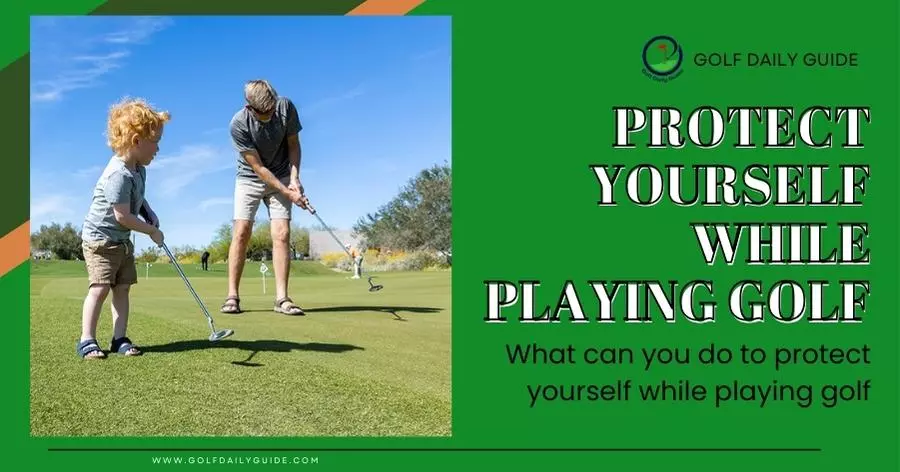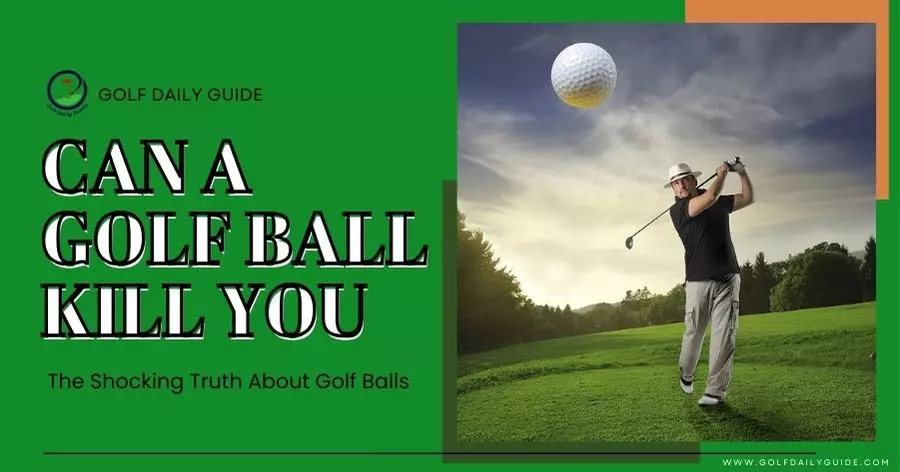Golf is a popular sport enjoyed by millions of people worldwide. From amateurs to professionals, golfers hit the greens for both leisure and competition.
But have you ever wondered whether a golf ball can kill you? This question may seem absurd, but it has been asked many times.
This blog post will explore the truth behind this inquiry and separate fact from fiction. So, keep reading to learn more, whether you’re an avid golfer or simply curious.
Is golf Dangerous?
Is golf dangerous? It’s a question that has been asked time and time again, especially when you see pro golfers hitting balls at incredible speeds.
But can a golf ball kill you? In this article, we’ll explore the potential risks associated with golf and answer this question once and for all.
First, let’s look at some statistics. According to a Consumer Product Safety Commission study, there were 15,000 golf-related injuries requiring emergency room treatment in 2015 alone.
These injuries ranged from minor cuts and bruises to more severe injuries such as concussions and broken bones.
While these numbers may seem alarming, it’s important to note that the vast majority of golf injuries are not life-threatening.
Now, let’s address the elephant in the room. Can a golf ball kill you?
The short answer is yes, it’s possible. Many golfers have died due to errant shots or balls. However, these incidents are incredibly rare. The chances of being killed by a golf ball are about 1 in 300,000,000.
So, while golf can be dangerous, it’s important to keep things in perspective. Every sport or activity comes with risks. But by taking proper safety precautions, you can minimize these risks and enjoy the game of golf without fear.
Here are some tips for staying safe on the golf course:
1. Always be aware of your surroundings. Pay attention to other golfers and where their shots are going.
2. Wear proper attire. This includes golf shoes with good traction and clothing that allows for freedom of movement.
3. Use proper equipment. Make sure your clubs are in good condition and fit you properly.
4. Follow the rules of the course. This includes staying out of hazards and not hitting into groups ahead of you.
5. Take golf lessons. Proper technique can help prevent injury.
In conclusion, while golf can be dangerous, the likelihood of being seriously injured or killed by a golf ball is incredibly low.
By taking proper safety precautions and following the course rules, you can enjoy the game of golf without fear. So, grab your clubs and hit the links – just stay safe out there!
How much force can a golf ball take?
A golf ball is designed to withstand a certain amount of force. The average swing speed for a golfer is around 100 miles per hour.
At this speed, a golf ball can experience a force of up to 4,000 Newtons (or 900 pounds). However, Modern golf balls handle even more force. 5,000 Newtons (over 1,100 pounds) is the maximum force some golf balls can handle.
So, can a golf ball kill you? The short answer is no. While a golf ball can certainly hurt if it hits you, it’s highly unlikely that it would be fatal.
According to a study by the US National Library of Medicine, the most common injuries caused by golf balls are to the head and eyes. However, these injuries are typically not life-threatening.
It’s worth noting, however, that there have been some rare cases of golf ball-related fatalities. In 1979, for example, a man was hit in the temple by a golf ball and died as a result of the impact. But such incidents are sporadic and should not deter anyone from enjoying the game of golf.

What can you do to protect yourself while playing golf?
The most important thing is to be aware of your surroundings. Always watch for other players and ensure you’re not standing in someone’s line of fire.
If you hear someone shout “fore,” take cover immediately. And, of course, always wear appropriate headgear and eye protection.
In conclusion, a golf ball is designed to withstand significant force. While it can undoubtedly hurt if it hits you, it’s highly unlikely that it would be fatal.
By taking appropriate safety precautions, you can enjoy the game of golf without putting yourself or others at risk. And remember, always shout “fore” if your ball is heading towards someone else.
How fast does a golf ball go?
Can a golf ball kill you? Golf is a game of skill, precision, and strategy. It’s a beloved sport that’s enjoyed by millions of people all over the world.
But have you ever wondered just how fast a golf ball can go? It’s a question that many people ask, and for good reason. After all, a golf ball is a small, dense object that’s hit with a great deal of force.
Firstly, let’s look at how fast a golf ball can go. The speed of a golf ball is measured in miles per hour (mph). The average speed of a golf ball hit by a professional golfer can reach up to 170 mph.
However, Golf ball speeds vary depending on the person who hits it, the kind of club used, and the conditions.
Now, let’s look at the science behind golf ball speed. A few key factors determine the speed of a golf ball – the speed of the clubhead at impact, the angle of the clubface, and the spin of the ball.
The angle of the clubface also plays a role in the speed of the ball. If the clubface is angled down at impact, it will add more loft to the ball, causing it to travel higher and slower. If the clubface is angled up, it will decrease the loft on the ball, causing it to travel lower and faster.
Finally, the spin of the ball affects its speed and trajectory. A ball with a backspin will travel higher and shorter, while a ball with a topspin will travel lower and farther.
What happens if a spectator moves a golf ball?
Golf is a sport loved by many individuals around the world. It’s a game that requires precision, accuracy, and patience.
And while it’s a game enjoying millions, it’s not without its rules and regulations. One such rule involves a spectator moving a golf ball. So what happens if a spectator moves a golf ball?
Firstly, it’s important to note that a spectator moving a golf ball violates the game’s rules. If a spectator moves the ball, it can result in a penalty stroke for the player. However, the severity of the penalty can vary depending on the situation.
If a spectator moves a golf ball in a casual round of golf, the penalty stroke may be less severe. The player may need to replace the ball to its original position and play on without further penalty.
But the penalty can be more severe in a more competitive round or tournament. In some cases, the player may need to take a penalty stroke and play the ball from where it landed after being moved by the spectator.
What if the situation involves a spectator being hit by the ball? Can a golf ball kill you?
While it’s rare for a golf ball to cause fatal injury, it’s not impossible. The speed and force at which a golf ball is hit can cause serious injury, particularly if the ball hits a vulnerable area of the body, such as the head or neck.
To prevent such incidents, golf courses have implemented safety measures such as warning signs and designated areas for spectators.
It’s important for spectators to be aware of their surroundings and to stay alert while watching the game.
In conclusion, a spectator moving a golf ball can result in a penalty stroke for the player, and the penalty’s severity can vary depending on the situation.
While rare, the speed and force of a golf ball can cause serious injury if it hits a vulnerable area of the body.
Both players and spectators must follow the rules and safety measures to ensure a safe and enjoyable game.

How many people die from golf balls per year?
Golf is a popular sport enjoying millions of people around the world. From amateurs to professionals, people of all ages and skill levels take to the greens to enjoy the fresh air, exercise, and friendly competition.
However, with any sport comes risk, and golf is no exception. One of the most common concerns among golfers is whether or not a golf ball can kill you.
In this blog post, I’ll explore the statistics and how many people die from golf ball accidents yearly. Can a Golf Ball Kill You?
The short answer is yes, a golf ball can kill you. Golf balls have caused multiple cases of death in recent years.
While these incidents are relatively rare, they are a stark reminder of the potential danger of playing golf:
1. Statistics on Golf Ball Deaths
According to a study published in the American Journal of Forensic Medicine and Pathology, there were 15 deaths cause by golf ball accidents between 2007 and 2016 in the United States alone.
That breaks down to an average of 1.5 deaths per year. Any preventable accident death is a tragedy, even though this number may seem low.
Moreover, this data only accounts for deaths in the United States. There may be additional cases of golf ball-related deaths in other countries that have not been documented.
2. What Causes Golf Ball Accidents?
Several factors can contribute to golf ball accidents. Some of the most common causes include:
Stray shots: Even the most skilled golfers can accidentally hit a ball in the wrong direction. Stray shots can hit other golfers, nearby pedestrians, or even passing cars.
Poorly designed courses: There are some golf courses design with hazards near fairways and greens. If a golfer hits their ball into one of these areas, they may accidentally hit someone nearby.
Lack of awareness: Golfers are responsible for always being aware of their surroundings. However, A distracted golfer may hit someone with their ball if they aren’t paying attention.
How to Prevent Golf Ball Accidents
Can a golf ball kill you? While golf ball accidents can be deadly, they are also largely preventable.
By following these tips, you can help reduce your risk of being injured by a golf ball:
Be aware of your surroundings: Whether you’re playing golf or simply walking near a course, always be aware of your surroundings. Pay attention to where balls are flying and take cover if necessary.
Stay out of harm’s way: Avoid walking too close to fairways or greens, and never stand behind someone hitting a ball.
Wear protective gear: If you’re playing golf, consider wearing a helmet or other protective gear. While this may not be practical or necessary for every golfer, it can provide an added layer of protection.
Frequently Asked Question
What makes golf balls shocking, and is there a shocking truth about them?
The term “shocking truth” about golf balls is often used metaphorically. However, interesting facts and details about golf balls might surprise many golfers and enthusiasts.
How many dimples are typically found on a golf ball, and why are they important?
The number of dimples on a golf ball can vary, but a standard modern golf ball usually has around 300 to 500 dimples. Dimples enhance the ball’s aerodynamics, helping it achieve better lift and distance by reducing drag.
Do different golf balls make a significant impact on performance?
Yes, different golf balls can affect performance. Golf balls vary in compression, cover material, and construction, influencing distance, spin, and feel. Choosing the right ball for your game and swing can improve performance.
What is the purpose of the core in a golf ball?
The core, typically made of synthetic rubber or a combination of materials, is the innermost layer of a golf ball. It affects the ball’s compression and determines its feel and distance capabilities. Higher compression cores are generally suitable for players with faster swing speeds.
Are there any environmental concerns related to golf balls?
Yes, there are environmental concerns. Many traditional golf balls contain non-degradable materials. When lost in water bodies, they can contribute to pollution. The development of biodegradable and eco-friendly golf balls is underway.
The color of a golf ball generally doesn’t significantly affect performance. However, some golfers believe specific colors are more accessible to track in the air or locate on the course. Personal preference and visibility should guide the choice of color.
Related Post
How to Clean Leather Golf Gloves
What is a reverse shotgun start in golf
What Time is Twilight Golf
Why golf has 18 holes
What are the 14 clubs in a golf bag
Final Thoughts
In conclusion, while a golf ball is not likely to kill a person, it can still cause severe injuries and even death in rare cases.
Golfers must follow safety guidelines and be aware of their surroundings to prevent accidents on the golf course.
Moreover, non-golfers should also exercise caution if they live near a golf course or engage in outdoor activities near golf courses.
Understanding the potential risks associated with golf balls can help promote a safer and more enjoyable experience for everyone involved.












